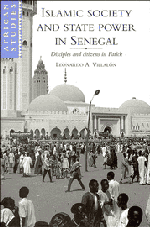Book contents
- Frontmatter
- Contents
- List of tables
- Acknowledgments
- A note on spelling
- Glossary
- Map of Senegal
- Introduction: good Africans, good citizens, good Muslims
- 1 Islam in the politics of state–society relations
- 2 The structure of society: Fatick in the Senegalese context
- 3 The state–citizen relationship: struggle over bridges
- 4 The marabout–disciple relationship I: foundations of recruiting and following
- 5 The marabout–disciple relationship II: the structures of allegiance
- 6 The state–marabout relationship: collaboration, conflict, and alternatives
- 7 Bureaucrats, marabouts, and citizen–disciples: how precarious a balance?
- Notes
- Select bibliography
- Index
- Titles in the series
6 - The state–marabout relationship: collaboration, conflict, and alternatives
Published online by Cambridge University Press: 10 November 2009
- Frontmatter
- Contents
- List of tables
- Acknowledgments
- A note on spelling
- Glossary
- Map of Senegal
- Introduction: good Africans, good citizens, good Muslims
- 1 Islam in the politics of state–society relations
- 2 The structure of society: Fatick in the Senegalese context
- 3 The state–citizen relationship: struggle over bridges
- 4 The marabout–disciple relationship I: foundations of recruiting and following
- 5 The marabout–disciple relationship II: the structures of allegiance
- 6 The state–marabout relationship: collaboration, conflict, and alternatives
- 7 Bureaucrats, marabouts, and citizen–disciples: how precarious a balance?
- Notes
- Select bibliography
- Index
- Titles in the series
Summary
The ambiguity towards Islam which marks the attitudes of the contemporary political elite in Senegal is a product of the same dilemma as that which characterized the relations between political and religious authorities in pre-colonial Senegambia. In Sine the buur, like other monarchs in the region, maintained good diplomatic ties with various important religious leaders, but he also recognized that they offered an alternative system of allegiances to that which maintained his position. Coumba Ndoffène Diouf fa ndepp, the second-to-last Buur-Siin who reigned from 1898 to 1924, kept particularly good ties with a Moorish maraboutic family from the town of Boutilimit in today's Mauritania. Cheikhouna ould Dada, a marabout from that family who was later to die in Fatick and be buried in the family cemetery of the buur's descendants, served as the buur's emissary to Amadou Bamba, founder of the Mouride order. Good relations with Bamba were cemented when the Buur-Siin intervened with the French to defend Bamba against the incriminating allegations made by a disgruntled son of Lat Dior Diop, the Damel of Cayor.
Cordial relations have been maintained among the descendants of all of these men. El Hajj Farba Diouf, the now quite old son of Coumba Ndoffène Diouf, regularly receives Moorish marabouts of ould Dada's family as guests. One of his sons, grandson to the buur, was given to the Moorish family to educate and subsequently spent seven years in Boutilimit, where he acquired a sound Arabic education.
- Type
- Chapter
- Information
- Islamic Society and State Power in SenegalDisciples and Citizens in Fatick, pp. 200 - 243Publisher: Cambridge University PressPrint publication year: 1995



